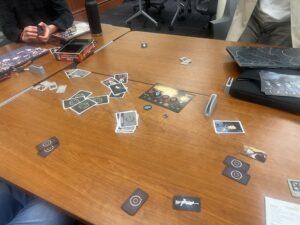I AM MAKING THIS EDIT CAN WE SEE IT ON CANVAS?
At this week’s game night, I played The Resistance, a social deduction board game for 5 to 10 players by Don Eskridge. The game’s target audience is adults and teenagers interested in the theme of espionage and social games.
The Resistance applies mechanics very similar to other social deduction games, like Mafia, relying on two teams of players: the resistance, who wants to win the game by identifying and excluding all the spies from their missions, and the spies, who win by successfully infiltrating the resistance and sabotaging their goals. Because the spies know who their allies are and the members of the resistance are in the dark, the best way for the players to identify the spies in their midst is to utilize the limited game mechanics at their disposal: team votes, successful and failed missions, and what the other players are saying. Thus, The Resistance becomes a classic example of a social deduction game that uses voting, sabotage, and, perhaps most importantly, discussion to create a social deduction game that promotes investigation mainly through player interaction.
Something The Resistance does particularly well is how it handles discussions between players. There are no limits to the amount of conversation the players can have and it is an explicit game mechanic that anyone can speak at any point in time. This mechanic, paired with the social deduction aspect of the game, creates interesting strategies for players on both sides. Spies could sow chaos and confusion by derailing conversations or interrupting others while speaking, and resistance members can frustrate the spies by taking their time before agreeing to vote on a selected team. As a spy, I caught myself telling the other players, “We should bring this to a vote,” because I knew the resistance to making a hasty decision would benefit me and my team. Ultimately, players interact with their fellow players for at least 30 minutes without rest, which allows for a vibrant social experience and the exchange of copious amounts of information. This feature sets it aside from games like Among Us or Mafia, where players are constrained in their communication, where players can only talk at specific times with time limits, and dead players cannot speak. Replacing the killing aspect with sabotage also makes it so that players are never eliminated from the game, even if the group is convinced they have identified a spy, a clever decision by the game designers to make sure players can be an active part of the game at all times – the boundaries of the game are thus never at risk. Player interaction remains at the same level throughout the game.
Through its mechanics, The Resistance prioritizes player interaction by providing the resistance with their most valuable tool: time. Players have no time limit between rounds, so they can interact as much as they want before voting. Even if a vote does not go through, the resistance has five chances to have a successful vote per round, allowing for unlimited discussion in those moments. Because the only risk-free information the resistance can gather comes from how individuals are voting and what they are saying, it is in the best interest of the resistance to keep everyone talking for as long as possible to discern who the spies are, either by discovering their intentions through their actions or by catching them in a lie. As a result, this game creates a dynamic where players are encouraged to interact as much as possible, creating a social deduction almost entirely driven by conversation. The narrative is less important than the fellowship, which is the main mode of fun The Resistance sets out to instill in the player. In my game, once the spies were only a turn away from winning, the resistance started to regret having moved through the rounds too quickly, pointing out that they didn’t have any accurate intel besides the failed missions. As a spy, I’m doubtful my strategy of moving the vote along as quickly as possible would work a second time with the same group.
This unlimited talking phase, however, can make games go on for particularly long, and it is not an unreasonable resistance strategy to wait out the spies until they catch them slipping up. A minor game modification that allows for time limits before a vote or team selection could improve the pacing of the game for spies, but they would have to accept some kind of disadvantage, such as having one less spy on their team. Regardless, with seven players playing, there were three spies and four resistance members, making it so that the resistance had to be extremely precise to select a mission team that contained no spies at all. An alternative to this may be allowing the resistance to have a role that allows them to identify spies, such as in the Inquisitor expansion that we did not play, to give the resistance an edge on the spies without having to rely solely on discussion. This would also speed up the game. Below is a picture of my win as a spy!




